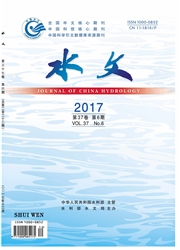

 中文摘要:
中文摘要:
应用大通河流域实测洪水资料和水利普查数据,定性和定量分析了梯级水电开发对流域洪水过程和洪水特征的影响,建立了梯级水电站数量与洪水涨落率、涨落频次的数学关系模型。结果表明:随着流域水电站数量的增多,洪水过程变化频繁,洪水涨落率增大,涨落频次增多;梯级水电开发使流域最大洪峰流量增大了19.7%~21.5%,最大洪峰传播时间减少了6.1%,而对次洪水总量的影响较小。研究水文过程受人类活动的影响规律,对加强流域水电站统一调度、水能水资源可持续利用和水生态文明建设具有十分重要的意义。
 英文摘要:
英文摘要:
The effect of the cascade hydroelectric development on the flood process and characteristics in the Datonghe River Basin was qualitatively and quantitatively analyzed by using the observed flood data and water resources survey data. The mathematical model was established to analyze the relationship between the number of hydropower stations, flood fluctuation rate, and flood fluctuation frequency at the representative hydrometry stations. The results show that the flood process changes frequently, flood fluctuation rate and fluctuation frequency increase along with the number of the hydropower stations increasing. The cascade hydroelectric development makes the maximum flood peak flow increase by 19.7%-21.5%, the flood routing duration decrease by 6.1%, while less effect on the total amount of a flood. The research on the influence regularity of human activities on hydrological process is very significant for strengthening unified dispatching of hydropower stations in a river basin, water sustainable utilization of water resources and water ecological civilization construction.
 同期刊论文项目
同期刊论文项目
 同项目期刊论文
同项目期刊论文
 Role of soil erodibility in affecting available nitrogen and phosphorus losses under simulated rainf
Role of soil erodibility in affecting available nitrogen and phosphorus losses under simulated rainf A Rainfall Simulation Study of Soil Erodibility and Available Nutrient Losses from Two Contrasting S
A Rainfall Simulation Study of Soil Erodibility and Available Nutrient Losses from Two Contrasting S Frequency analysis of precipitation extremes in Heihe River basin based on generalized Pareto distri
Frequency analysis of precipitation extremes in Heihe River basin based on generalized Pareto distri Analytical studies on transient groundwater flowinduced by land reclamation using different fill mat
Analytical studies on transient groundwater flowinduced by land reclamation using different fill mat Role of soil erodibility in affecting available nitrogenand phosphorus losses under simulated rainfa
Role of soil erodibility in affecting available nitrogenand phosphorus losses under simulated rainfa Calibration of a large-scale groundwater flow model using GRACE data: a case study in the Qaidam Bas
Calibration of a large-scale groundwater flow model using GRACE data: a case study in the Qaidam Bas Identification of the impacts of climate changes and human activities on runoff in the upper and mid
Identification of the impacts of climate changes and human activities on runoff in the upper and mid Temporal variations of reference evapotranspiration and its sensitivity to meteorological factors in
Temporal variations of reference evapotranspiration and its sensitivity to meteorological factors in 期刊信息
期刊信息
